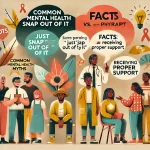Mental Health vs. Mental Illness: What People Get Wrong
Many people believe that mental health and mental illness are the same thing—but they’re not. This confusion leads to harmful stigma, misconceptions, and even avoidance of professional help.
Just like physical health includes both wellness and illness, mental health is a spectrum. You don’t have to be mentally ill to take care of your mental well-being, just like you don’t need to have diabetes to eat healthily.
In this post, I will break down the key differences between mental health and mental illness and address some of the biggest misconceptions people have about both.
What Is Mental Health?
Mental health refers to your overall psychological and emotional well-being. It affects:
- How you handle stress and daily challenges
- How you relate to others
- Your ability to work, function, and enjoy life
A person can have good mental health even if they experience stress, sadness, or frustration from time to time—these are normal emotions. Taking care of your mental health is preventative—just like exercising to maintain physical health.
💡 Key takeaway: Everyone has mental health. You don’t have to be mentally ill to work on improving it.
What Is Mental Illness?
Mental illness refers to specific diagnosable conditions that affect a person’s thoughts, emotions, and behaviors in a way that disrupts daily life. These conditions require professional intervention and may include:
- Depression
- Anxiety disorders
- Bipolar disorder
- Schizophrenia
- PTSD
Mental illnesses aren’t just “having a bad day” or “feeling down.” They are persistent, often require treatment, and cannot simply be “snapped out of.”
💡 Key takeaway: Mental illness is not the same as mental health struggles. You can struggle with mental health without having a diagnosable illness, and you can have a diagnosed illness while still working toward better mental health.
Common Misconceptions About Mental Health and Mental Illness
🚫 Misconception #1: “If someone talks about mental health, they must have a mental illness.”
✅ Reality: Mental health is for everyone! You don’t need to have a diagnosis to see a psychologist, just like you don’t need to have a disease to see a doctor for a check-up.
🚫 Misconception #2: “Mental illness is just a weakness or overreaction.”
✅ Reality: Mental illness is a legitimate medical condition, just like heart disease or diabetes. It’s not about “being strong enough”—it’s about brain chemistry, genetics, and life experiences.
🚫 Misconception #3: “Therapy is only for people with serious mental illness.”
✅ Reality: Therapy helps with stress, relationships, personal growth, and everyday challenges. Many people go to therapy to build resilience and self-awareness, not just for mental illness.
🚫 Misconception #4: “If I don’t have a mental illness, I don’t need to do anything for my mental health.”
✅ Reality: Just like we exercise and eat well to stay physically healthy, we should also take care of our mental health through stress management, emotional awareness, and self-care.
Why Does This Distinction Matter?
Understanding the difference between mental health and mental illness helps:
✅ Reduce stigma around mental health conversations
✅ Encourage more people to seek support before things become overwhelming
✅ Promote mental well-being for everyone, not just those with a diagnosis
Taking care of your mental health doesn’t mean you’re weak—it means you’re proactive about living a fulfilling life.
Final Thoughts
Mental health is for everyone, not just those with a diagnosis. Whether you’re dealing with stress, relationship struggles, or just want to grow emotionally, therapy can be a valuable tool.
If you’d like to explore ways to improve your mental well-being, book a consultation today and take the first step toward a healthier mindset.




